Design and Simulation of High-Performance D-Type Dual-Mode PCF-SPR Refractive Index Sensor Coated with Au-TiO2 Layer
Abstract
:1. Introduction
2. Theoretical Modeling
3. Model and Structural Parameter Analysis
3.1. Model Analysis
3.2. Structural Parameter Analysis
- (1)
- Large air hole diameter d3
- (2)
- Gold film thickness t1
- (3)
- TiO2 thickness t2
- (4)
- Microgroove depth dp
4. Analysis of RI Sensing Characteristics
5. Conclusions
Author Contributions
Funding
Institutional Review Board Statement
Informed Consent Statement
Data Availability Statement
Conflicts of Interest
References
- Barnes, W.L.; Dereux, A.; Ebbesen, T.W. Surface plasmon subwavelength optics. Nature 2003, 424, 824–830. [Google Scholar] [CrossRef] [PubMed]
- Chen, T.Y.; Xin, J.L.; Chang, S.J.; Chen, S.J.; Liu, J.T. Surface Plasmon Resonance (SPR) Combined Technology: A Powerful Tool for Investigating Interface Phenomena. Adv. Mater. Interfaces 2023, 10, 2202202. [Google Scholar] [CrossRef]
- Kim, S.A.; Kim, S.J.; Moon, H.; Jun, S.B. In vivo optical neural recording using fiber-based surface plasmon resonance. Opt. Lett. 2012, 37, 614–616. [Google Scholar] [CrossRef]
- Opoku, G.; Danlard, I.; Dede, A.; Akowuah, E.K. Design and numerical analysis of a circular SPR based PCF biosensor for aqueous environments. Results Opt. 2023, 12, 100432. [Google Scholar] [CrossRef]
- Mishra, S.K.; Tripathi, S.N.; Choudhary, V.; Gupta, B.D. Surface plasmon resonance-based fiber optic methane gas sensor utilizing graphene-carbon nanotubes-poly (methyl methacrylate) hybrid nanocomposite. Plasmonics 2015, 10, 1147–1157. [Google Scholar] [CrossRef]
- Patel, K.S.; Surve, J.; Baz, A.; Parmar, Y. Optimization of Novel 2D material based SPR Biosensor using Machine Learning. IEEE Trans. Nanobiosci. 2024, 23, 328–335. [Google Scholar] [CrossRef]
- Caucheteur, C.; Voisin, V.; Albert, J. Near-infrared grating-assisted SPR optical fiber sensors: Design rules for ultimate refractometric sensitivity. Opt. Express 2015, 23, 2918–2932. [Google Scholar] [CrossRef]
- Piliarik, M.; Párová, L.; Homola, J. High-throughput SPR sensor for food safety. Biosens. Bioelectron. 2009, 24, 1399–1404. [Google Scholar] [CrossRef]
- Iqbal, A.M.T.; Kumar, R.S.; Santosh, K. Recent Advancement in Fiber-Optic based SPR Biosensor for Food Adulteration Detection—A Review. IEEE Trans. Nanobiosci. 2023, 22, 978–988. [Google Scholar]
- Écija-Arenas, Á.; Kirchner, E.M.; Hirsch, T.; Fernández-Romero, J.M. Development of an aptamer-based SPR-biosensor for the determination of kanamycin residues in foods. Anal. Chim. Acta 2021, 1169, 338631. [Google Scholar] [CrossRef]
- Choi, Y.; Lee, Y.; Hong, S. Tailor-made mesoporous SiO2/Au thin film with a substitutable interface for highly sensitive and selective room-temperature gas detection of VOCs. Sens. Actuators B-Chem. 2022, 373, 132763. [Google Scholar] [CrossRef]
- Ikeda, M.; Matsui, H.; Yano, Y.; Yamahara, H.; Tabata, H. Integrating zeolite nanoparticles with plasmonic waveguides for ellipsometric detection of acetone gas molecules. Sens. Actuators B-Chem. 2021, 344, 130310. [Google Scholar] [CrossRef]
- Nooke, A.; Beck, U.; Hertwig, A.; Krause, A.; Krüger, H.; Lohse, V.; Negendank, D.; Steinbach, J. On the application of gold based SPR sensors for the detection of hazardous gases. Sens. Actuators B-Chem. 2010, 149, 194–198. [Google Scholar] [CrossRef]
- Zhang, S.Q.; Han, B.; Zhang, Y.N.; Liu, Y.X.; Zheng, W.L.; Zhao, Y. Multichannel Fiber Optic SPR Sensors: Realization Methods, Application Status, and Future Prospects. Laser Photonics Rev. 2022, 16, 2200009. [Google Scholar] [CrossRef]
- Chung, J.W.; Kim, S.D.; Bernhardt, R.; Pyun, J.C. Application of SPR biosensor for medical diagnostics of human hepatitis B virus (hHBV). Sens. Actuators B-Chem. 2005, 111, 416–422. [Google Scholar] [CrossRef]
- Hassani, A.; Skorobogatiy, M. Design of the microstructured optical fiber-based surface plasmon resonance sensors with enhanced microfluidics. Opt. Express 2006, 14, 11616–11621. [Google Scholar] [CrossRef] [PubMed]
- Guan, C.Y.; Yuan, L.B.; Shi, J.H. Microstructured-Fiber Surface Plasmon Resonance Sensor. Acta Opt. Sin. 2011, 31, 42–45. [Google Scholar]
- Li, B.; Cheng, T.L.; Chen, J.X.; Yan, X. Graphene-enhanced surface plasmon resonance liquid refractive index sensor based on photonic crystal fiber. Sensors 2019, 19, 3666. [Google Scholar] [CrossRef]
- Shafkat, A. Analysis of a gold coated plasmonic sensor based on a duplex core photonic crystal fiber. Sens. Bio-Sens. Res. 2020, 28, 100324. [Google Scholar] [CrossRef]
- Yasli, A.; Ademgil, H. Multianalyte sensing analysis with multilayer photonic crystal fiber-based surface plasmon resonance sensor. Mod. Phys. Lett. B 2020, 34, 2050375. [Google Scholar] [CrossRef]
- Tian, M.; Lu, P.; Chen, L.; Lv, C.; Liu, D.M. All-solid D-shaped photonic fiber sensor based on surface plasmon resonance. Opt. Commun. 2012, 285, 1550–1554. [Google Scholar] [CrossRef]
- An, G.W.; Li, S.G.; Qin, W.; Zhang, W.; Fan, Z.K.; Bao, J.J. High-sensitivity refractive index sensor based on D-shaped photonic crystal fiber with rectangular lattice and nanoscale gold film. Plasmonics 2014, 9, 1355–1360. [Google Scholar] [CrossRef]
- An, G.W.; Li, S.G.; Wang, H.Y.; Zhang, X.N. Metal oxide-graphene-based quasi-D-shaped optical fiber plasmonic biosensor. IEEE Photonics J. 2017, 9, 6803309. [Google Scholar] [CrossRef]
- Paul, A.K.; Sarkar, A.K.; Islam, M.H.; Morshed, M. Dual core photonic crystal fiber based surface plasmon resonance biosensor. Optik 2018, 170, 400–408. [Google Scholar] [CrossRef]
- Sakib, M.N.; Hossain, M.B.; Al-tabatabaie, K.F.; Mehedi, I.M.; Hasan, M.T.; Hossain, M.A.; Amiri, I.S. High performance dual core D-shape PCF-SPR sensor modeling employing gold coat. Results Phys. 2019, 15, 102788. [Google Scholar] [CrossRef]
- Melwin, G.; Senthilnathan, K. High sensitive D-shaped photonic crystal fiber sensor with V-groove analyte channel. Optik 2020, 213, 164779. [Google Scholar] [CrossRef]
- Kiroriwal, M.; Singal, P. Design and analysis of highly sensitive solid core gold coated hexagonal photonic crystal fiber sensor based on surface plasmon resonance. J. Nanophotonics 2021, 15, 026008. [Google Scholar] [CrossRef]
- Singh, S.; Prajapati, Y.K. Highly sensitive dual-core symmetrical side-polished modified D-shaped SPR based PCF refractive index sensor with deeply etched micro openings. Optik 2021, 235, 166657. [Google Scholar] [CrossRef]
- Lee, Y.S.; Lim, K.S.; Zaini, M.K.A.; Ahmad, H. Mode Splitting Based on Polarization Manipulation in Few-Mode Fiber. IEEE J. Quantum Elect. 2018, 54, 6800306. [Google Scholar] [CrossRef]
- Wang, S.; Liu, X.; Wang, H.; Hu, G. High-order mode fiber laser based on few-mode fiber gratings. Opt. Laser Technol. 2022, 155, 108416. [Google Scholar] [CrossRef]
- Chen, N.; Ding, X.; Wang, L.Y.; Xu, Y.M.; Guo, L.H.; Huang, Y.M.; Liu, C.X.; Xu, Y.R.; Guo, W.H.; Xiao, Y.P. Numerical analysis of a compact all-fiber polarization beam splitter based on dual-core photonic crystal fiber with As2S3 thin layer. Results Phys. 2024, 56, 107273. [Google Scholar] [CrossRef]
- Nagasaki, A.; Saitoh, K.; Koshiba, M. Polarization characteristics of photonic crystal fibers selectively filled with metal wires into cladding air holes. Opt. Express 2011, 19, 3799–3808. [Google Scholar] [CrossRef] [PubMed]
- Wang, T.; Zhang, M.; Liu, K.; Jiang, J.F.; Zhao, Y.H.; Ma, J.Y.; Liu, T.G. The effect of the TiO2 film on the performance of the optical fiber SPR sensor. Opt. Commun. 2019, 448, 93–97. [Google Scholar] [CrossRef]
- Rifat, A.A.; Ahmed, R.; Mahdiraji, G.A.; Adikan, F.R.M. Highly sensitive D-Shaped photonic crystal fiber based plasmonic biosensor in visible to Near-IR. IEEE Sens. J. 2017, 17, 2776–2783. [Google Scholar] [CrossRef]
- Liu, Q.; Li, S.; Li, J.S.; Dou, C.; Wang, X.Y.; Wang, G.Y.; Shi, M. Tunable fiber polarization filter by filling different index liquids and gold wire into photonic crystal fiber. J. Lightwave Technol. 2016, 34, 2484–2490. [Google Scholar] [CrossRef]
- Santos, D.; Guerreiro, A.; Baptista, J. SPR optimization using metamaterials in a D-type PCF refractive index sensor. Opt. Fiber Technol. 2017, 33, 83–88. [Google Scholar] [CrossRef]
- Chen, N.; Chang, M.; Lu, X.L.; Zhou, J.; Zhang, X.D. Numerical Analysis of Midinfrared D-Shaped Photonic-Crystal-Fiber Sensor Based on Surface-Plasmon-Resonance Effect for Environmental Monitoring. Appl. Sci. 2020, 10, 3897. [Google Scholar] [CrossRef]
- Kaur, V.; Singh, S. Design of D-Shaped PCF-SPR sensor with dual coating of ITO and ZnO conducting metal oxide. Optik 2020, 220, 165135. [Google Scholar] [CrossRef]
- An, G.W.; Hao, X.P.; Li, S.G.; Yan, X.; Zhang, X.N. D-shaped photonic crystal fiber refractive index sensor based on surface plasmon resonance. Appl. Opt. 2017, 56, 6988–6992. [Google Scholar] [CrossRef]
- Dash, J.N.; Jha, R. On the performance of graphene-based D-shaped photonic crystal fibre biosensor using surface plasmon resonance. Plasmonics 2015, 10, 1123–1131. [Google Scholar] [CrossRef]
- Dash, J.N.; Jha, R. Highly sensitive side-polished birefringent PCF-based SPR sensor in near IR. Plasmonics 2016, 11, 1505–1509. [Google Scholar] [CrossRef]
- Liu, Q.; Sun, J.D.; Sun, Y.D.; Liu, W.; Wang, F.M.; Yang, L.; Liu, C.; Liu, Q.; Li, Q.; Ren, Z.H.; et al. Surface plasmon resonance sensor based on eccentric core photonic quasi-crystal fiber with indium tin oxide. Appl. Opt. 2019, 58, 6848–6853. [Google Scholar] [CrossRef] [PubMed]
- Liu, C.; Su, W.Q.; Liu, Q.; Lu, X.L.; Wang, F.; Sun, T.; Chu, P.K. Symmetrical dual D-shape photonic crystal fibers for surface plasmon resonance sensing. Opt. Express 2018, 26, 9039–9049. [Google Scholar] [CrossRef] [PubMed]
- Liu, C.; Yang, L.; Liu, Q.; Wang, F.M.; Sun, Z.J.; Sun, T.; Mu, H.W.; Chu, P.K. Analysis of a surface plasmon resonance probe based on photonic crystal fibers for low refractive index detection. Plasmonics 2018, 13, 779–784. [Google Scholar] [CrossRef]
- Wang, G.Y.; Lu, Y.; Duan, L.C.; Yao, J.Q. A refractive index sensor based on PCF with ultra-wide detection range. IEEE J. Sel. Top. Quantum Electron. 2020, 27, 5600108. [Google Scholar] [CrossRef]
- Liu, C.; Wang, J.W.; Wang, F.M.; Su, W.Q.; Yang, L.; Lv, J.W.; Fu, G.L.; Li, X.L.; Liu, Q.; Sun, T.; et al. Surface plasmon resonance (SPR) infrared sensor based on D-shape photonic crystal fibers with ITO coatings. Opt. Commun. 2020, 464, 125496. [Google Scholar] [CrossRef]


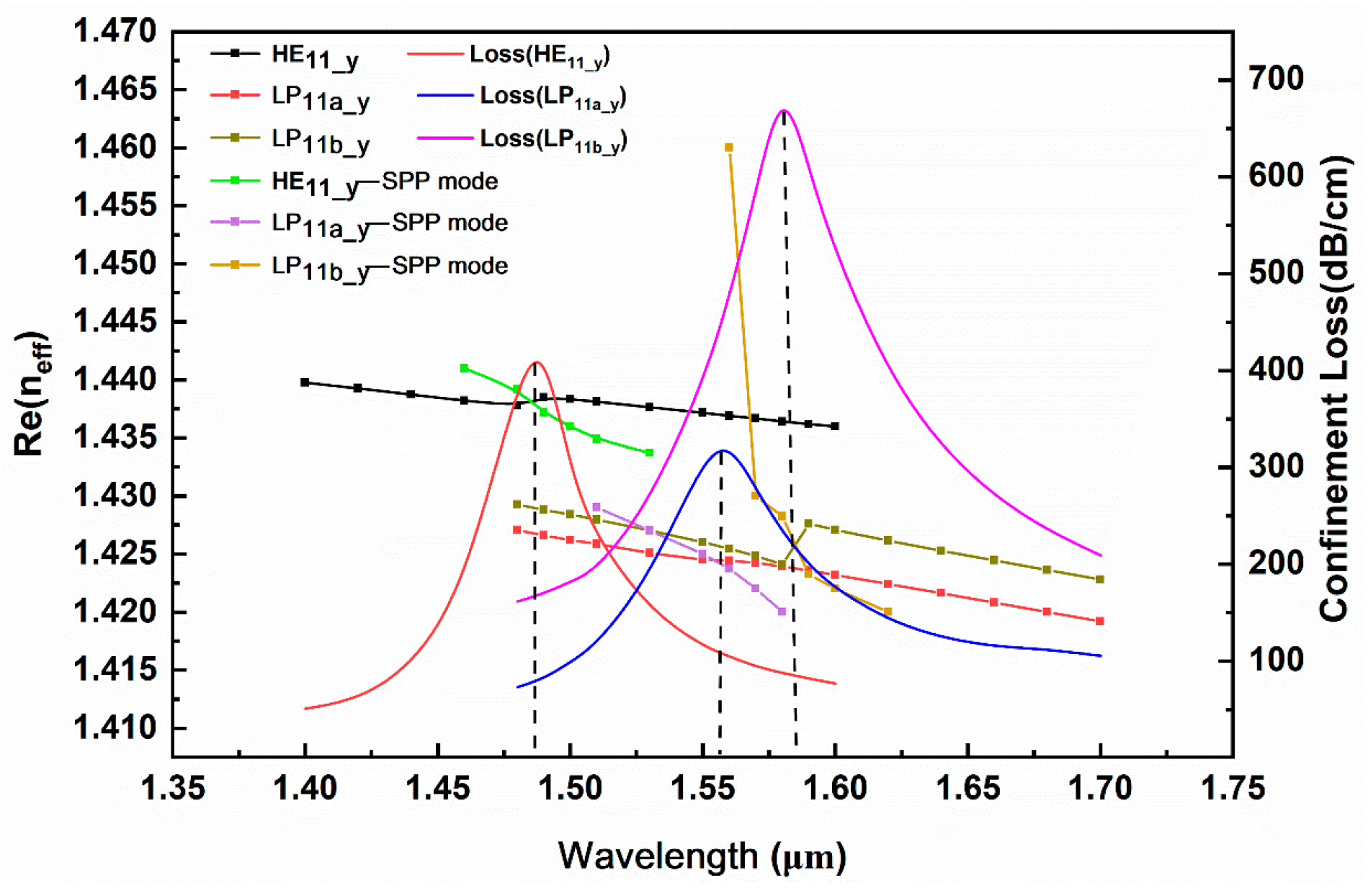


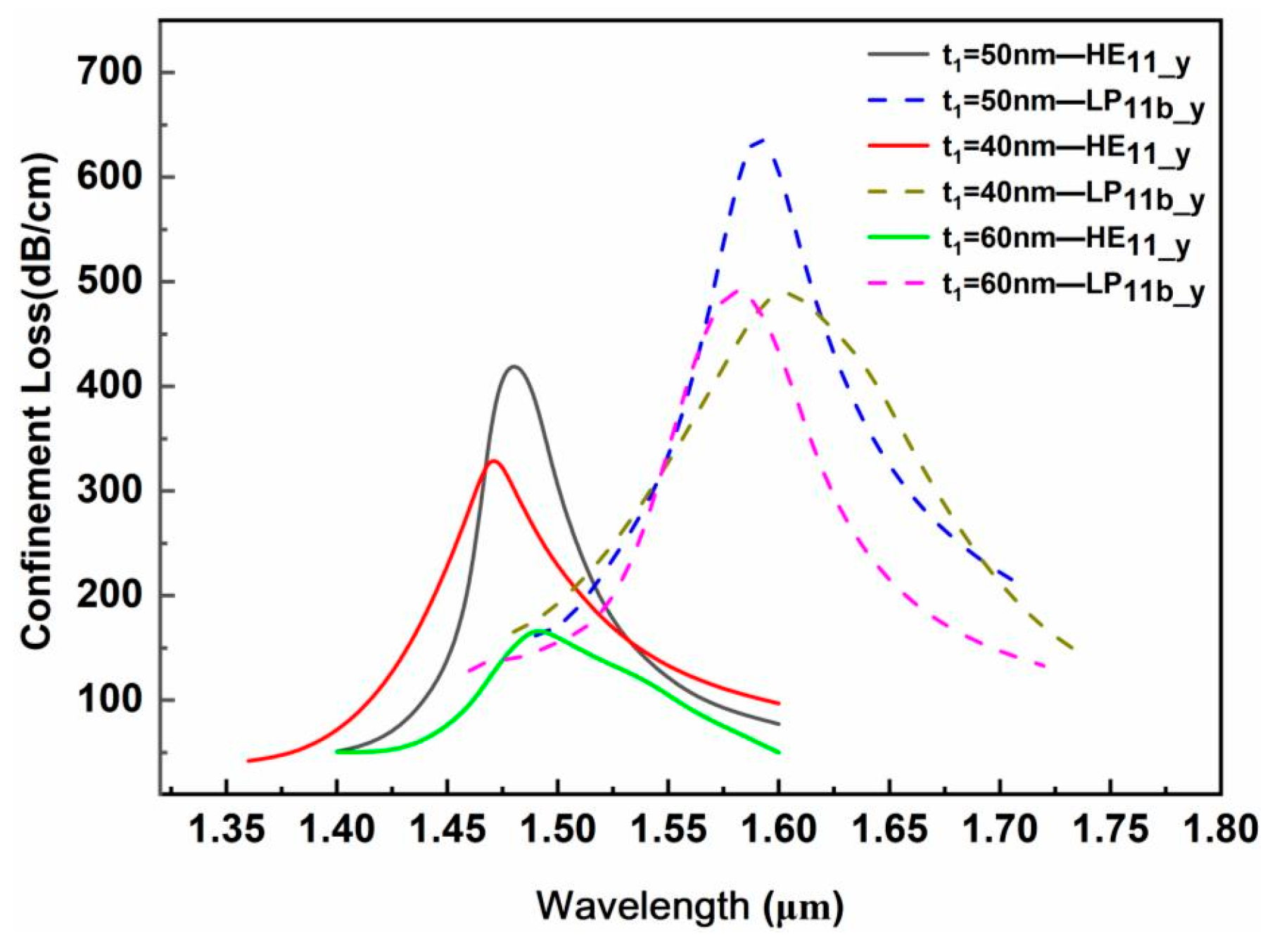

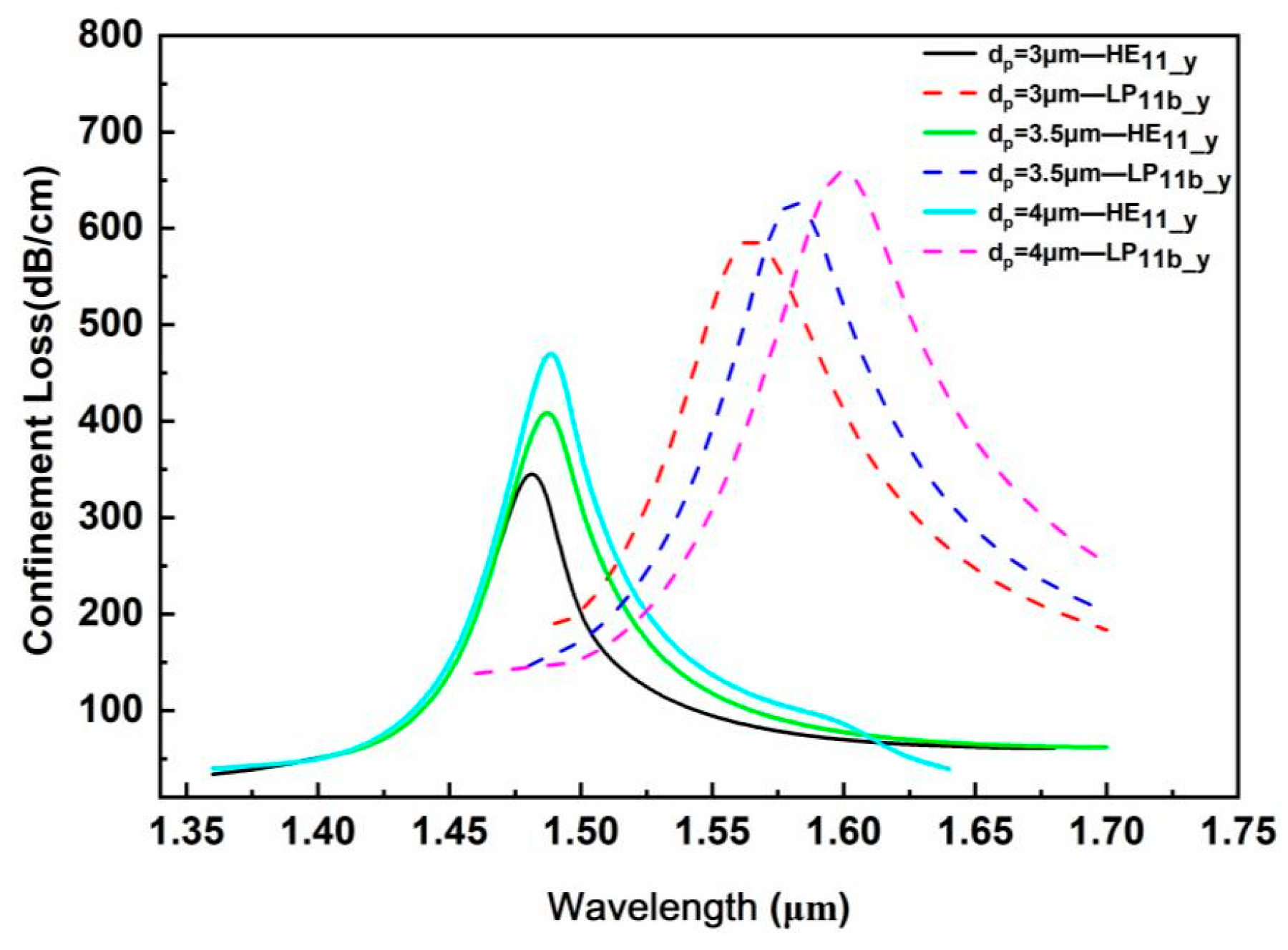
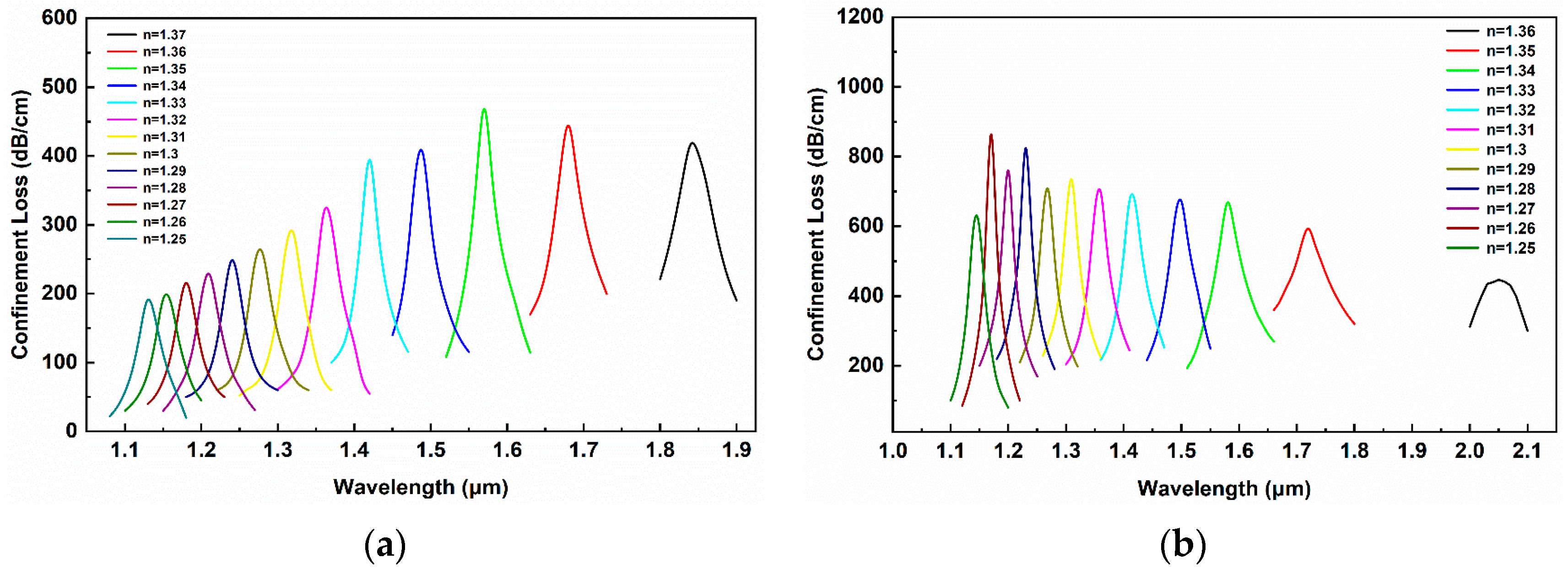
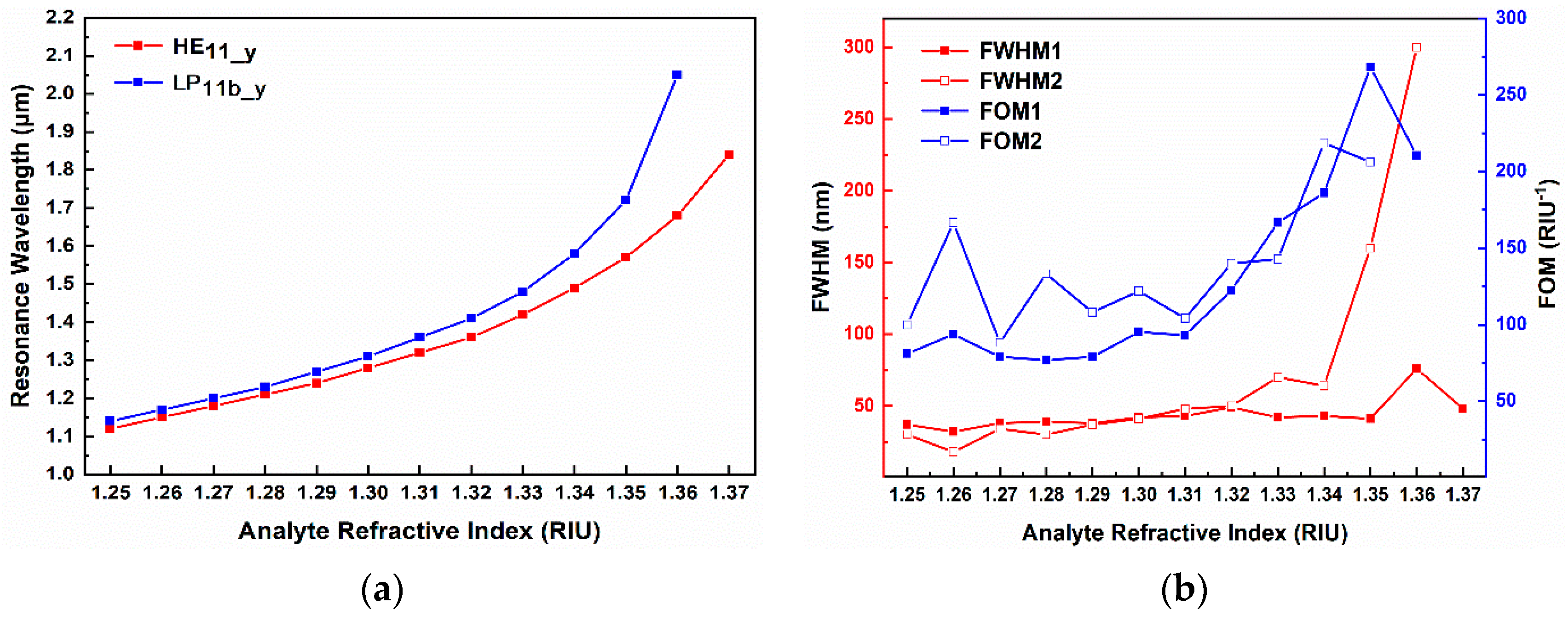
| Refs. | RI Range | Wavelength Range (nm) | Max Sensitivity (nm/RIU) | Resolution (RIU) | FOM | |
|---|---|---|---|---|---|---|
| [39] | 1.33–1.38 | 2030–2310 | 10,493 | 9.53 × 10−6 | N/A | |
| [40] | 1.33–1.37 | 480–650 | 3700 | 2.7 × 10−5 | N/A | |
| [41] | 1.33–1.35 | 1870–2300 | 17,000 | 5.8 × 10−6 | N/A | |
| [42] | 1.33–1.39 | 1400–2200 | 21,100 | 4.739 × 10−6 | 106.81 | |
| [43] | 1.36–1.41 | 650–1440 | 14,660 | 6.82 × 10−6 | 250 | |
| [44] | 1.27–1.36 | 550–1100 | 2350 | 2.8 × 10−5 | N/A | |
| [45] | x-polarized y-polarized | 1.29–1.36 | 1150–2200 1160–2200 | 4157 3704 | 2.41 × 10−8 | N/A |
| [46] | 1.22–1.33 | 1200–2250 | 15,000 | 6.67 × 10−6 | N/A | |
| This work | HE11_y LP11b_y | 1.25–1.37 1.25–1.36 | 1120–1840 1150–2050 | 16,000 33,000 | 6.25 × 10−6 3.03 × 10−6 | 268.29 206.25 |
Disclaimer/Publisher’s Note: The statements, opinions and data contained in all publications are solely those of the individual author(s) and contributor(s) and not of MDPI and/or the editor(s). MDPI and/or the editor(s) disclaim responsibility for any injury to people or property resulting from any ideas, methods, instructions or products referred to in the content. |
© 2024 by the authors. Licensee MDPI, Basel, Switzerland. This article is an open access article distributed under the terms and conditions of the Creative Commons Attribution (CC BY) license (https://creativecommons.org/licenses/by/4.0/).
Share and Cite
Ding, X.; Lin, Q.; Wang, M.; Liu, S.; Zhang, W.; Chen, N.; Wang, Y. Design and Simulation of High-Performance D-Type Dual-Mode PCF-SPR Refractive Index Sensor Coated with Au-TiO2 Layer. Sensors 2024, 24, 6118. https://doi.org/10.3390/s24186118
Ding X, Lin Q, Wang M, Liu S, Zhang W, Chen N, Wang Y. Design and Simulation of High-Performance D-Type Dual-Mode PCF-SPR Refractive Index Sensor Coated with Au-TiO2 Layer. Sensors. 2024; 24(18):6118. https://doi.org/10.3390/s24186118
Chicago/Turabian StyleDing, Xin, Qiao Lin, Mengjie Wang, Shen Liu, Weiguan Zhang, Nan Chen, and Yiping Wang. 2024. "Design and Simulation of High-Performance D-Type Dual-Mode PCF-SPR Refractive Index Sensor Coated with Au-TiO2 Layer" Sensors 24, no. 18: 6118. https://doi.org/10.3390/s24186118
APA StyleDing, X., Lin, Q., Wang, M., Liu, S., Zhang, W., Chen, N., & Wang, Y. (2024). Design and Simulation of High-Performance D-Type Dual-Mode PCF-SPR Refractive Index Sensor Coated with Au-TiO2 Layer. Sensors, 24(18), 6118. https://doi.org/10.3390/s24186118







